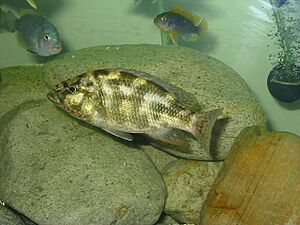Nimbochromis polystigma facts for kids
Quick facts for kids Nimbochromis polystigma |
|
|---|---|
 |
|
 |
|
| Adult male in full breeding dress (above) and female/immature (below) | |
| Conservation status | |
| Scientific classification | |
| Synonyms | |
|
The Nimbochromis polystigma is a cool type of cichlid fish. It lives only in Lake Malawi, which is part of the huge Great Rift Valley in Africa. This fish likes to hang out in places where there are rocks and sand, or where lots of plants grow underwater. It can grow to be about 23 centimeters (that's about 9 inches) long!
Contents
About the Nimbochromis polystigma
You can find Nimbochromis polystigma all over Lake Malawi. This fish is a fish-eater, meaning it loves to hunt and eat smaller fish, especially young cichlids.
The "Sleeper" Fish
Local people call this fish Kaligono, which means 'sleeper' in the chiCheŵa language. It shares this name with other Nimbochromis species because of its special hunting trick. The fish will lie very still on the bottom of the lake, sometimes even on its side, as if it's pretending to be dead! When small fish come closer to check it out, the Nimbochromis polystigma quickly pounces on them.
When it's hunting this way, its colors become lighter. Scientists think this lighter color might attract more small cichlids, making them curious enough to get close. These fish also sometimes hide in plants and then suddenly attack smaller fish. Their spotted colors help them blend in, acting like camouflage.
How They Reproduce
Like most cichlids from Lake Malawi, the Nimbochromis polystigma is a mouthbrooder. This means the female fish carries her eggs and young babies inside her mouth! She keeps them safe there for about two to three weeks before letting them go into the water.
Keeping Nimbochromis polystigma in an Aquarium
If you're thinking about having a Nimbochromis polystigma as a pet, they are usually quite peaceful fish. However, you need to make sure their tank mates aren't small enough to become their dinner!
Feeding and Tank Needs
These fish are very excited eaters. They will happily munch on all the usual foods that cichlids eat. They also have a fun habit: they might even jump out of the water to try and grab food or your fingers!
In a home aquarium, these fish can grow even bigger, up to 30 centimeters (about 12 inches). Because they get so big, they need a really large fish tank—at least 300 liters (which is about 80 US gallons). You can keep them with other types of cichlids, like haplochromines and most mbuna. It's a good idea to put some rocks in the tank so they have places to hide if they feel scared. But they also need plenty of open space to swim around.


